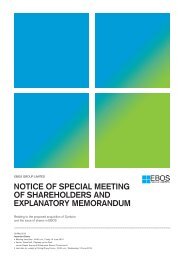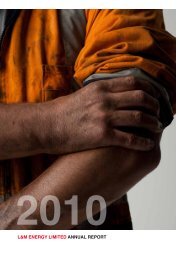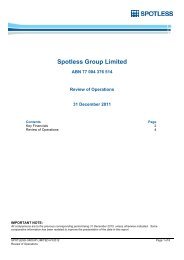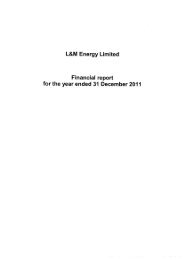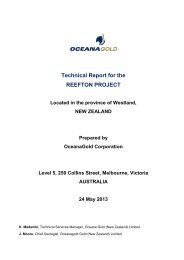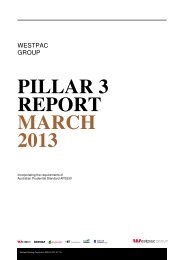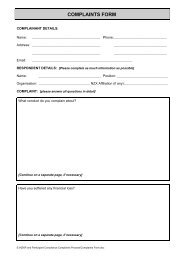NZSX/ NZDX Listing Rules APPENDIX 1 Part A (Rules 10.4.2 ... - NZX
NZSX/ NZDX Listing Rules APPENDIX 1 Part A (Rules 10.4.2 ... - NZX
NZSX/ NZDX Listing Rules APPENDIX 1 Part A (Rules 10.4.2 ... - NZX
You also want an ePaper? Increase the reach of your titles
YUMPU automatically turns print PDFs into web optimized ePapers that Google loves.
THE 2004 AUSTRALASIAN CODE FOR REPORTING EXPLORATION RESULTS, MINERAL RESOURCES AND ORE RESERVES (THE JORC CODE)<br />
of the application of technical and economic<br />
parameters to be used for detailed planning.’ and<br />
‘Caution should be exercised if this category is<br />
considered in technical and economic studies’.<br />
The Competent Person should take into consideration<br />
issues of the style of mineralisation and cut-off grade<br />
when assessing geological and grade continuity.<br />
Cut-off grades chosen for the estimation should be<br />
realistic in relation to the style of mineralisation.<br />
24.Mineral Resource estimates are not precise calculations,<br />
being dependent on the interpretation of limited<br />
information on the location, shape and continuity of the<br />
occurrence and on the available sampling results. Reporting<br />
of tonnage and grade figures should reflect the relative<br />
uncertainty of the estimate by rounding off to appropriately<br />
significant figures and, in the case of Inferred Mineral<br />
Resources, by qualification with terms such as ‘approximately’.<br />
In most situations, rounding to the second significant<br />
figure should be sufficient. For example 10,863,000<br />
tonnes at 8.23 per cent should be stated as 11 million<br />
tonnes at 8.2 per cent. There will be occasions,<br />
however, where rounding to the first significant figure<br />
may be necessary in order to convey properly the<br />
uncertainties in estimation. This would usually be<br />
the case with Inferred Mineral Resources.<br />
To emphasise the imprecise nature of a Mineral<br />
Resource estimate, the final result should always be<br />
referred to as an estimate not a calculation.<br />
Competent Persons are encouraged, where<br />
appropriate, to discuss the relative accuracy and/or<br />
confidence of the Mineral Resource estimates. The<br />
statement should specify whether it relates to global<br />
or local estimates, and, if local, state the relevant<br />
tonnage or volume. Where a statement of the relative<br />
accuracy and/or confidence is not possible, a<br />
qualitative discussion of the uncertainties should be<br />
provided (refer to Table 1).<br />
25.Public Reports of Mineral Resources must specify one<br />
or more of the categories of ‘Inferred’, ‘Indicated’ and<br />
‘Measured’. Categories must not be reported in a<br />
combined form unless details for the individual<br />
categories are also provided. Mineral Resources must<br />
not be reported in terms of contained metal or mineral<br />
content unless corresponding tonnages and grades are<br />
also presented. Mineral Resources must not be aggregated<br />
with Ore Reserves.<br />
Public Reporting of tonnages and grades outside the<br />
categories covered by the Code is not permitted unless<br />
the situation is covered by Clause 18, and then only in<br />
strict accordance with the requirements of that clause.<br />
Estimates of tonnage and grade outside of the<br />
categories covered by the Code may be useful for a<br />
company in its internal calculations and evaluation<br />
processes, but their inclusion in Public Reports could<br />
cause confusion.<br />
26.Table 1 provides, in a summary form, a list of the main<br />
criteria which should be considered when preparing<br />
reports on Exploration Results, Mineral Resources and<br />
Ore Reserves. These criteria need not be discussed in a<br />
Public Report unless they materially affect estimation<br />
or classification of the Mineral Resources.<br />
It is not necessary, when publicly reporting, to<br />
comment on each item in Table 1, but it is essential<br />
to discuss any matters which might materially affect<br />
the reader’s understanding or interpretation of the<br />
results or estimates being reported. This is particularly<br />
important where inadequate or uncertain data affect<br />
the reliability of, or confidence in, a statement of<br />
Exploration Results or an estimate of Mineral<br />
Resources or Ore Reserves; for example, poor sample<br />
recovery, poor repeatability of assay or laboratory<br />
results, limited information on bulk densities etc.<br />
If there is doubt about what should be reported, it is<br />
better to err on the side of providing too much<br />
information rather than too little.<br />
Uncertainties in any of the criteria listed in Table 1<br />
that could lead to under- or over-statement of<br />
resources should be disclosed.<br />
Mineral Resource estimates are sometimes reported<br />
after adjustment from reconciliation with production<br />
data. Such adjustments should be clearly stated in a<br />
Public Report of Mineral Resources and the nature<br />
of the adjustment or modification described.<br />
27.The words ‘ore’ and ‘reserves’ must not be used in<br />
describing Mineral Resource estimates as the terms imply<br />
technical feasibility and economic viability and are only<br />
appropriate when all relevant Modifying Factors have<br />
been considered. Reports and statements should<br />
continue to refer to the appropriate category or<br />
categories of Mineral Resources until technical feasibility<br />
and economic viability have been established. If reevaluation<br />
indicates that the Ore Reserves are no longer<br />
viable, the Ore Reserves must be reclassified as Mineral<br />
Resources or removed from Mineral Resource/Ore<br />
Reserve statements.<br />
It is not intended that re-classification from Ore<br />
Reserves to Mineral Resources or vice versa should<br />
be applied as a result of changes expected to be of a<br />
short term or temporary nature, or where company<br />
management has made a deliberate decision to<br />
operate on a non-economic basis. Examples of such<br />
situations might be commodity price fluctuations<br />
expected to be of short duration, mine emergency of<br />
a non-permanent nature, transport strike etc.<br />
Note: Code is in normal typeface, guidelines are in indented italics, definitions are in bold.<br />
~ 9 ~



